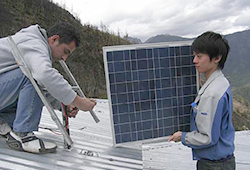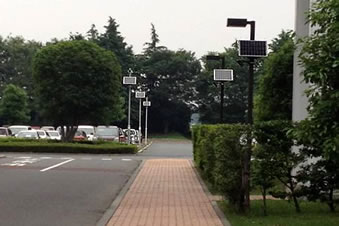Middle Capa Division
How We Developed the Solar light
The Idea
- Solar lighting can be expensive
- They can be difficult to maintain
(i.e. batteries die quickly) - Their performance depends on the weather
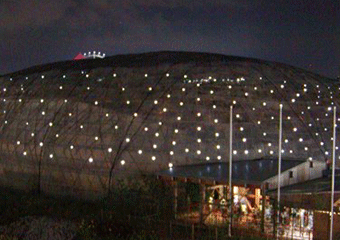
How We Developed the Solar light
In response to feedback about poor battery life, we chose to use a capacitor over the lead acid batteries that were common at the time. The Small Capa used two A5000 capacitors (8Wh) from Advanced Capacitor Technologies. Under normal conditions (25℃ ), capacitors can generally operate over 30,000 charge-discharge cycles, which gives them an edge over lead acid batteries. However, capacitors are expensive and are only capable of storing small amounts of electrical power, about 16Wh. Due to the small storage capacity of our battery, we named our first solar light the Small Capa. The first Small Capa was installed in the Kiyotake Kindergarten in Miyazaki in 2008.
Compared to lead acid batteries, capacitors have a small internal resistance. We decided to use this characteristic to our advantage, making it possible to achieve a full charge regardless of weather. This proved to be a huge advantage for using a capacitor over a lead acid battery. After measuring performance over a month, we found that the capacitor was able to charge fully nearly every day, falling short of a full charge about three or four days per month (see attached data). Even in June, which is in the middle of Japan's rainy season, there was only one day that the capacitor did not fully charge.
Despite the good performance, we were faced with the challenge of how to power the lights during the four days that the capacitor could not charge fully. Although it would have been easy to add a reserve capacitor for these days, this was not a cost-effective solution considering these capacitors' high cost.
This is where we turned our focus to another one of a capacitor's characteristics, the principle that voltage is directly proportional to its capacity to store charge. For typical lead acid and chemical batteries, it is not possible to get an accurate measure of charge from the measured voltage. However, with capacitors, if you can measure the voltage, you can easily calculate the amount of charge that is stored. We based our new control system on this principle.
Specifically, we measured the voltage of the capacitor in the evening, before the LEDs were turned on. The brightness of the LEDs was then determined by the amount of charge that was calculated from the capacitor's voltage. For a full charge, the LEDs would shine as bright as it is rated, throughout the night and until a predetermined time. However, the brightness of the LED would decrease proportionally to battery charge. For example, if it is 78% charged when measured, the LEDs will shine at 78% of their rated brightness. We decided to trade off a small amount of brightness to ensure operation throughout the night. By implementing this system, we successfully eliminated the need for a reserve capacitor. Because this system adjusts to the weather conditions, we named this control system the Weather Synchronization System.
The development of the Weather Synchronization System successfully solved one of solar lighting's largest drawbacks, its dependence on good weather, in a cost-effective and compact way.
The Small Capa, which uses a capacitor for storage and the Weather Synchronization System for smart weather adjustments found a following among early adopters of solar lighting. Until we displaced the Small Capa in 2010 with its successor, the Middle Capa, we sold 292 Small Capa's, 61 in Japan and 231 overseas.
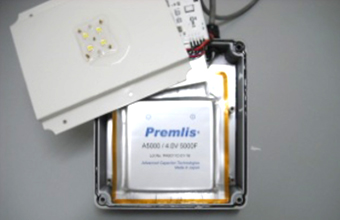
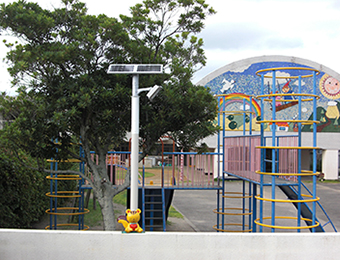
Although the Small Capa found a niche market, we received feedback that it was not bright enough to be useful as an outdoor light. At the time, we marketed the Small Capa towards people living in rural areas, as can be seen in our catalog from that time. Accordingly, many Small Capa were installed in rural areas and overseas (i.e. Bhutan, Afghanistan, and places where there is no readily available electricity). Even though the charging efficiency and lifespan of the capacitor were widely praised by customers, we began to shift our focus towards lithium ion batteries. In particular, we decided to use a Toshiba battery, SCiB. SCiB uses lithium titanite, which varies greatly from the lithium ion batteries used in phones and laptops. It can withstand 10,000 charge-discharge cycles (about 27 years) with only a 10% decrease in storage capacity. With the switch to SCiB, we maintained a long battery lifespan, while simultaneously tripling our electrical power output, now totaling at 50Wh. Accordingly, we increased the brightness of our solar lights, which led us to replacing the Small Capa with the Middle Capa.
One difficulty we faced when transitioning to lithium ion batteries was that, unlike capacitors, it is not possible to get an accurate measurement of the charge from a simple measurement of voltage. This is where we used a coulomb counter, which is an integrated circuit that adds up current over the course of the day. This enabled us to know exactly how much charge the battery had accumulated over the course of the day. Based on this data, we updated our Weather Synchronization System. SCiB have significantly more storage capacity than lead acid batteries, but can perform inconsistently with inclement weather. With the help of the Weather Synchronization System 2, our solar lights stay on throughout the night regardless of weather conditions.
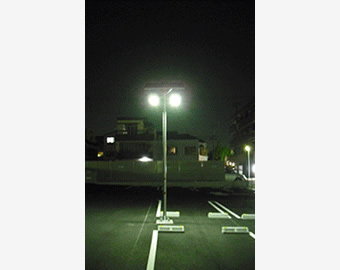
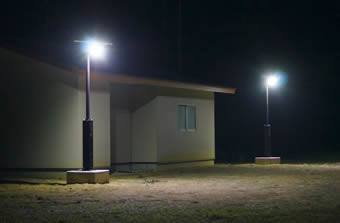
In addition to providing lighting, our newest models include functionality for smartphone charging and power outlets that can be used during emergencies. We have also added a GPS to make accurate estimates of time, information that is used when turning the lights on and off. Because of our hard work, our sales since 2012 have been very promising. As of 2015, we have sold 3000 solar lights in eight years.

Even though other companies use solar panels to harvest solar energy (from small panels used for household generation to large mega solar projects), many of these solar powered projects face large electrical losses. Typically, there is a conversion loss when converting the original DC current to an AC current. Then there is a transmission loss when transmitting the electricity far away (e.g. from the solar plant to a household). Finally, there is another conversion loss, because many household appliances use DC.
Compared to this process, solar lights generate a DC current that connects directly to its LEDs, mitigating the need for any conversions or transmissions. It turns out that solar lights are one of the most efficient ways to use solar energy.
It may be true that one solar light does not make a big difference. However, throughout Japan, and throughout the entire world, there are countless street lights. Try to imagine a world where 10% of these lights are solar powered. That would be a massive change. We at L-Kougen work day and night striving to make this change a reality.
